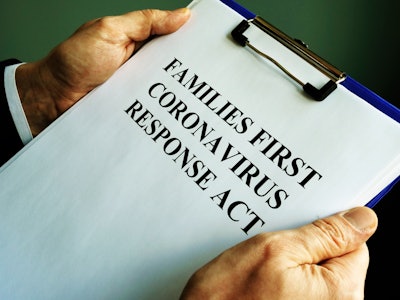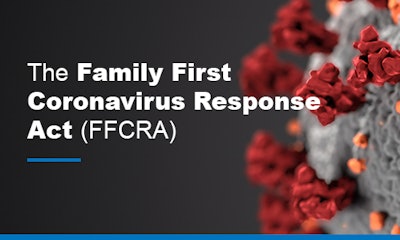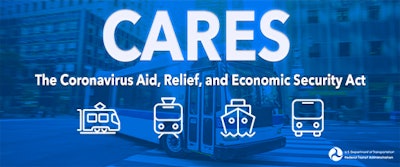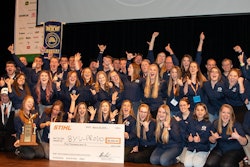
Take a look at the qualifications of both acts, as well as how they can benefit landscaping company owners during the coronavirus (COVID-19) pandemic.
Families First Coronavirus Relief Act (FFCRA)
The FFCRA went into effect on April 1 and requires certain employers to pay sick or family leave wages to employees who are unable to work or telework due to certain circumstances related to the coronavirus.
With the FFCRA, employers are entitled to a refundable tax credit for the required leave pay, up to a specified limit, and it will apply to leave taken between April 1 and December 31.
Qualifying employees
The Department of Labor’s Wage and Hour Division (WHD) will administer and enforce this new law’s paid leave requirements, and the act provides that all employers provide to all employees: two weeks (or up to 80 hours) of paid sick leave at the employee’s regular rate of pay or two weeks (up to 80 hours) of paid sick leave at two-thirds the employee’s regular rate of pay due to the following:
- The employee is subject to a Federal, State or local quarantine or isolation order due to COVID-19;
- The employee has been advised by a health care provider to self-quarantine due to COVID-19;
- The employee is experiencing COVID-19 symptoms and is seeking a medical diagnosis;
- The employee is caring for an individual subject to the first two reasons;
- The employee is caring for a child whose school or place of care is closed or childcare provider is unavailable due to COVID-19;
- The employee is experiencing any other substantially similar conditions specified by the Secretary of Health and Human Services and the Secretaries of Labor and Treasury.
Only employees that fall under these six qualifying standards are eligible for leave; it does not apply to employees who are afraid of reporting to work out of fear of contracting the virus.
“The one we’re seeing the most of is the emergency sick leave, and that means if an employee can justify any of the six reasons, they can immediately get two weeks fully paid,” says Andrew Bray, VP of government relations with the National Association of Landscape Professionals (NALP). “You can’t take it out of their PTO, vacation or sick leave, and they immediately get full pay under that act.”
For the employer, Bray says they are then allowed to deduct what they are paying for that person off of their payroll taxes. Bray says that at first, NALP was concerned that businesses wouldn’t be able to use that credit until they filed their 2020 taxes, but after joining with other groups to lobby, Congress made the change that allowed it to count this year.
“We’re encouraging all of our employers to take any sort of potential outbreak in their company very seriously or, also, the fact that they have any employees that probably have weird situations (maybe with childcare), and let that person get two weeks’ paid and they can reap some benefits and recoup a large portion of that,” says Bray.
Small businesses
Small businesses with fewer than 50 employees may qualify for exemption from the requirements if they can prove that providing leave to an employee would jeopardize the viability of the business. Other exemptions include if leave is requested due to a child’s school or place of care being closed or if a childcare provider is unavailable due to COVID-19.
If an authorized officer of the business has determined that at least one of these three Small Business Exemptions conditions is satisfied, the business could also be exempt:
- If the provision of the paid sick leave or expanded family and medical leave would result in the company’s financial obligations and expenses exceeding available business revenues, causing the company to cease operating at minimal capacity.
- If the absence of the employee/employees requesting leave would entail a substantial risk to the operational capabilities or the financial health of the company because of their specialized skills, business knowledge or responsibilities.
- If there aren’t sufficient workers who are able, willing, qualified and available at the place and time needed to perform labor/services provided by the employee/employees requesting leave, and that these services are needed to allow the business to operate at minimal capacity.
“I’ve been telling everybody, just get in there!” says Bray. “There is a limit to these loans. They didn’t make this an infinite slush fund, so I would encourage everybody to get your application in and see what you can get. Maybe you don’t get all of it, but if there’s a chance to keep people on your payroll and help support your business over these next two months, I want everyone taking advantage of that.”
To see more FAQ regarding the FFCRA, click here.
CARES Act
The CARES Act was passed by Congress on March 27, which is a financial assistance package for small and mid-size businesses, including franchisors and franchisees.
For landscapers, Bray says the CARES Act offers payroll tax deductions for companies, and primarily, it opens up two types of loans: Small Business Administration Loans (SBAL) and the Payroll Protection Program (PPP).

Paycheck Protection Program (PPP)
Bray says the PPP is a hot item right now because companies with under 500 employees are looking at their business wondering how they can keep people on payroll while still being able to function.
“The government wanted companies to keep people on payroll rather than sending them all to the unemployment lines,” says Bray. “I know that’s not possible for every company, but that’s the thought process behind this.”
If you have these economic hardships based on COVID-19, Bray recommends keeping your payroll, not reducing wages and applying for this loan.
According to Forbes, the PPP may have a principal loan amount of up to $10 million, and loans may have a term of up to 10 years and bear interest at a rate of no more than 4 percent per annum, with payments to be deferred for at least six months and at most one year.
Additionally, Forbes says the PPP loans will be allowed to be used for payroll support (including paid sick or medical leave), insurance premiums, employee salaries, mortgage, rent and utility payments and other debt obligations.
Bray says the application process is fairly straightforward. Businesses will fill out the application online at the Small Business Administration’s (SBA) website, show their payroll (payroll is based on the average salary for the last year; seasonal businesses can take a screenshot of February to June 2019), show what’s needed to pay for the next 60-90 days of operation and if approved, businesses will then go to a certified lender to move forward with the loan. The key aspect of this loan, Bray says, is that you must keep people on your payroll.
“If you keep people on the payroll, there’s a strong chance that the loan could turn into a grant, meaning you’re not going to have to pay it back,” says Bray. “It’s called a loan, but if you keep people on payroll and satisfy some other conditions of the loan when you actually get it, you don’t have to pay anything back. Or if you do, it’s very minimal.”
If you start laying people off, Bray says you may end up owing a portion of the loan or the entire loan back.
Bray says that if you are a company with over 500 employees, you cannot apply for the PPP loans, but you also do not have to comply with the FFCRA.
If you are a company with under 500 employees and you have to comply with FFCRA but you also need to get a PPP, Bray says you can do that, but you are not allowed to take the tax credit and get the PPP loan.
“If you are not in compliance, you are certainly subjecting yourself to scrutiny by the Federal government but could even expose yourself to liability from an employee that is claiming that they are not allowed this,” says Bray. “You could get slapped on the wrist two ways: the Federal government could come down and say you’re in violation of a law, and I think there could be grounds for an individual employee to say that you violated their rights in a civil action.”
To see more FAQ regarding the CARES Act, click here.











